Enzyme catalysis Study guides, Class notes & Summaries
Looking for the best study guides, study notes and summaries about Enzyme catalysis? On this page you'll find 716 study documents about Enzyme catalysis.
Page 3 out of 716 results
Sort by
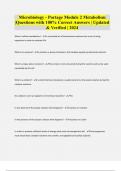
-
Microbiology - Portage Module 2 Metabolism |Questions with 100% Correct Answers | Updated & Verified | 2024
- Exam (elaborations) • 14 pages • 2024
- Available in package deal
-
- $12.08
- + learn more
What is cellular metabolism? - a controlled set of biochemical reactions that occur in living organisms in order to maintain life What is an enzyme? - a protein, or group of proteins, that catalyze (speed up) chemical reactions What is unique about enzymes? - the enzyme is not consumed during the reaction and can be used repeatedly by the cell What is a cofactor? - a small chemical component, usually metal ions, that assist enzymes during the catalysis reactions
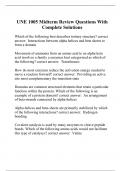
-
UNE CHEM 1005 Midterm Review Questions With Complete Solutions
- Exam (elaborations) • 15 pages • 2023
- Available in package deal
-
- $12.99
- + learn more
Which of the following best describes tertiary structure? correct answer: Interactions between alpha helices and beta sheets to form a domain Movement of ammonia from an amino acid to an alpha-keto acid involves a family a enzymes best categorized as which of the following? correct answer: Transferases How do most enzymes reduce the activation energy needed to move a reaction forward? correct answer: Providing an active site most complementary the transition state Domains are common ...
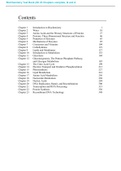
-
BioChemistry Test Bank (All 23 chapters complete, Questions and Answers with complete solutions
- Exam (elaborations) • 362 pages • 2022
-
- $10.99
- 3x sold
- + learn more
Contents Chapter 1 Introduction to Biochemistry 1 Chapter 2 Water 10 Chapter 3 Amino Acids and the Primary Structures of Proteins 27 Chapter 4 Prot eins: Three-Dimensional Structure and Function 46 Chapter 5 Properties of Enzymes 65 Chapter 6 Mechanisms of Enzymes 85 Chapter 7 Coenzymes and Vitamins 104 Chapter 8 Carbohydrates 119 Chapter 9 Lipids and Membranes 137 Chapter 10 Introduction to Metabolism 153 Chapter 11 Glycolysis 169 Chapter 12 Gluconeogenesis, The Pentose Phosphate Pathway, and G...
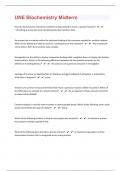
-
UNE Biochemistry Midterm 140 Questions with 100% Correct Answers | Updated | Guaranteed A+
- Exam (elaborations) • 17 pages • 2024
- Available in package deal
-
- $8.49
- + learn more
How do most enzymes reduce the activation energy needed to move a reaction forward? - ️️Providing an active site most complementary the transition state An enzyme has a mutation within the substrate binding of the coenzyme needed for covalent catalysis. Which of the following is likely to result as a consequence of this mutation? - ️️The enzyme will not be able to form the transition state complex Hemoglobin has the ability to display cooperative binding while myoglobin does not di...
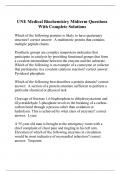
-
UNE Medical Biochemistry Midterm Questions With Complete Solutions
- Exam (elaborations) • 14 pages • 2023
- Available in package deal
-
- $11.49
- + learn more
Which of the following proteins is likely to have quaternary structure? correct answer: A multimeric protein that contains multiple peptide chains Prosthetic groups are complex nonprotein molecules that participate in catalysis by providing functional groups that form a covalent intermediate between the enzyme and the substrate. Which of the following is an example of a coenzyme or cofactor that participates in a covalent catalysis reaction? correct answer: Pyridoxal phosphate Which of t...
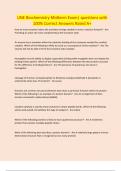
-
UNE Biochemistry Midterm Exam| questions with 100% Correct Answers Rated A+
- Exam (elaborations) • 17 pages • 2024
- Available in package deal
-
- $12.99
- + learn more
How do most enzymes reduce the activation energy needed to move a reaction forward? - Ans Providing an active site most complementary the transition state An enzyme has a mutation within the substrate binding of the coenzyme needed for covalent catalysis. Which of the following is likely to result as a consequence of this mutation? - Ans The enzyme will not be able to form the transition state complex
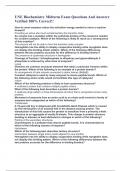
-
UNE Biochemistry Midterm Exam Questions And Answers Verified 100% Correct!!
- Exam (elaborations) • 12 pages • 2023
- Available in package deal
-
- $13.99
- + learn more
UNE Biochemistry Midterm Exam Questions And Answers Verified 100% Correct!! How do most enzymes reduce the activation energy needed to move a reaction forward? Providing an active site most complementary the transition state An enzyme has a mutation within the substrate binding of the coenzyme needed for covalent catalysis. Which of the following is likely to result as a consequence of this mutation? The enzyme will not be able to form the transition state complex Hemoglobin has the abili...
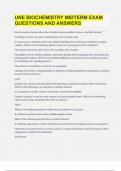
-
UNE BIOCHEMISTRY MIDTERM EXAM QUESTIONS AND ANSWERS
- Exam (elaborations) • 16 pages • 2023
- Available in package deal
-
- $14.99
- + learn more
How do most enzymes reduce the activation energy needed to move a reaction forward? Providing an active site most complementary the transition state We have an expert-written solution to this problem! An enzyme has a mutation within the substrate binding of the coenzyme needed for covalent catalysis. Which of the following is likely to result as a consequence of this mutation? The enzyme will not be able to form the transition state complex Hemoglobin has the ability to display ...
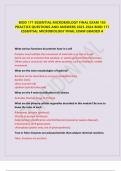
-
BIOD 171 ESSENTIAL MICROBIOLOGY FINAL EXAM 183 PRACTICE QUESTIONS AND ANSWERS 2023-2024 BIOD 171 ESSENTIAL MICROBIOLOGY FINAL EXAM GRADED A
- Exam (elaborations) • 46 pages • 2024
-
- $13.99
- + learn more
BIOD 171 ESSENTIAL MICROBIOLOGY FINAL EXAM 183 PRACTICE QUESTIONS AND ANSWERS BIOD 171 ESSENTIAL MICROBIOLOGY FINAL EXAM GRADED A What various functions do proteins have in a cell Proteins may facilitate the movement of materials in or out of a cell. Some can act as enzymes that catalyze, or speed up, biochemical processes. Others play a structural role while other proteins, such as filaments, enable movement. What are the main morphologies of bacteria? Bacteria can be described as coc...
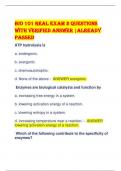
-
Bio 101 REAL Exam 2 QUESTIONS WITH VERIFIED ANSWER |ALREADY PASSED
- Exam (elaborations) • 32 pages • 2023
- Available in package deal
-
- $13.99
- + learn more
Bio 101 REAL Exam 2 QUESTIONS WITH VERIFIED ANSWER |ALREADY PASSED ATP hydrolysis is a. endergonic. b. exergonic. c. chemoautotrophic. d. None of the above - ANSWER exergonic. Enzymes are biological catalysts and function by a. increasing free energy in a system. b. lowering activation energy of a reaction. c. lowering entropy in a system. d. increasing temperature near a reaction. - ANSWER lowering activation energy of a reaction. Which of the following contribute to the speci...

How much did you already spend on Stuvia? Imagine there are plenty more of you out there paying for study notes, but this time YOU are the seller. Ka-ching! Discover all about earning on Stuvia


